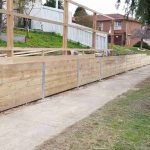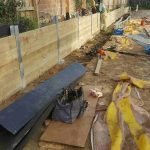Introduction
Retaining walls are important structures in landscaping and civil engineering, developed to keep back soil and prevent erosion. They enter into play in numerous terrains, from high slopes to flat ground. Comprehending the various Retaining Wall Construction Methods for Different Terrains is crucial for anyone involved in building or landscaping. This article digs deep into the art and science of retaining wall construction, exploring the methods fit for varied landscapes, products used, and common challenges faced. We'll also cover popular products like timber sleeper, concrete sleeper, and H beam, in addition to why it's recommended to work with a professional for your retaining wall projects.
Retaining Wall Building Methods for Various Terrains
When it concerns constructing a retaining wall, the option of method frequently depends upon the terrain type. Here we will explore some strategies that cater particularly to different landscapes.
Understanding Surface Types and Their Challenges
Flat Terrain- In flat terrains, maintaining walls primarily serve visual purposes or small soil retention. The challenge here typically depends on drain; improper drain can result in water pooling behind the wall.
- Sloped surfaces provide more substantial challenges due to gravitational forces acting on the soil. Retaining walls must be designed to withstand these forces effectively.
- Hilly surfaces require robust building options due to the capacity for landslides. Proper engineering is crucial to guarantee stability.
- Coastal regions may face unique challenges such as saltwater corrosion. Materials used need to be resistant to such environmental factors.
Key Factors Affecting Retaining Wall Design
When thinking about Retaining Wall Construction Methods for Various Terrains, a number of factors enter play:

- Soil Type: Clay soils might retain water, while sandy soils drain quickly but supply less support. Height of the Wall: Taller walls need advanced engineering options like tiered styles or reinforced structures. Water Drain: Effective drain systems are critical in avoiding hydrostatic pressure buildup behind the wall.
Materials Used in Maintaining Walls
Choosing the ideal product is key in making sure sturdiness and effectiveness:
- Timber Sleeper: Often used in residential tasks, wood sleepers are visually pleasing but have a much shorter lifespan compared to concrete options. Concrete Sleeper: Concrete sleepers use greater toughness and can endure harsher environmental conditions. They are ideal for both residential and industrial applications. H Beam: These structural beams supply excellent assistance and can be incorporated into different styles depending upon the required strength.
Designing Retaining Walls: A Detailed Approach
Step 1: Preparation Your Wall
Before you begin building a retaining wall, comprehensive preparation is necessary:
Assess your surface utilizing topographical maps. Determine whether you require authorizations based upon regional regulations. Choose your materials carefully-- will you use timber sleeper, concrete sleeper, or H beam?Step 2: Determining Dimensions
Calculating dimensions involves comprehending the height of your wall and just how much soil it will require to keep:
- Use solutions associated with triangular areas if you're developing tiered walls. Consider safety margins based on soil types and ecological conditions.
Step 3: Digging a Trench
A strong foundation is vital:
- Dig a trench that's deep enough for your picked product-- a minimum of one-third of its height if using concrete sleeper.
Step 4: Installing Drainage Solutions
The importance of drain can't be overemphasized:
- Incorporate weep holes or perforated pipes at regular periods behind your wall.
Step 5: Building Your Wall
Now comes the amazing part-- construction!
- For timber sleeper walls, begin placing sleepers horizontally; secure them with stakes driven into the ground. For concrete sleeper walls, stack them according to design specs; ensure they're level before proceeding.
Step 6: Backfilling Soil
After setup comes http://felixqepd366.theburnward.com/retaining-wall-installer-vs-home-builder-comprehending-the-differences backfilling:
- Use gravel or rocks at first before including soil-- this assists with drainage.
Common Mistakes in Retaining Wall Construction
Even skilled home builders can make errors that lead to costly repair work later:
Neglecting Drainage- Failing to incorporate sufficient drain can lead to structural failure over time.
- Not accounting for lateral earth pressure can lead to collapsing walls under stress.
- Using timber sleeper in wet locations without proper treatment can result in rot prematurely.
Maintenance Tips for Keeping Walls
Once you have actually successfully constructed a retaining wall, preserving it makes sure durability:
Check Drain Systems Regularly- Ensure that weep holes are clear of particles; this avoids water buildup that could compromise structural integrity.
- Look out for any indications of cracking or shifting; address them right away before they worsen.
- Keep turf and plants far from your wall's base; roots can penetrate and destabilize it over time.
FAQs
Q1: What materials ought to I utilize for constructing a maintaining wall?
A1: Common materials include timber sleeper for aesthetic appeals, concrete sleeper for sturdiness, and H beam for structural stability depending upon your requirements and surface type.

Q2: How do I guarantee my retaining wall won't fail?
A2: Making sure proper drain systems are set up and determining dimensions accurately will assist prevent failures due to hydrostatic pressure or bad style choices.
Q3: Can I develop a retaining wall myself?
A3: While it's possible with do it yourself packages readily available today, hiring a professional is frequently advised particularly if handling complex surfaces or big structures.
Q4: What's much better-- timber sleeper or concrete sleeper?
A4: It depends on your specific requirements; wood uses visual appeal however less longevity while concrete provides toughness appropriate even in harsher environments.
Q5: Do I require a permit to build a keeping wall?
A5: Yes, numerous places require permits specifically if you're changing land considerably; talk to regional policies first!
Q6: How deep need to my foundation trench be?
A6: Ideally, it needs to be at least one-third of your wall's height but always consult local standards as this might differ by region!
Conclusion
In conclusion, comprehending various Retaining Wall Construction Methods for Different Terrains equips you with indispensable knowledge whether you're an avid DIYer or wanting to work with specialists. By carefully thinking about factors like surface type, material choice (timber sleeper vs concrete), reliable drain solutions, maintenance practices, you'll create not simply practical structures but also enduring elements that improve your landscape's charm while making sure security versus erosion dangers. So roll up those sleeves-- or phone that professional-- and get started on creating something spectacular!